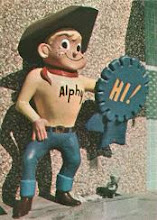 Many of the retail chains featured on this site were known for an iconic look – a combination of architecture, signage and interior decoration that made their stores instantly recognizable. While this remains largely true today, one could argue that it reached a peak during the 1960’s.
Many of the retail chains featured on this site were known for an iconic look – a combination of architecture, signage and interior decoration that made their stores instantly recognizable. While this remains largely true today, one could argue that it reached a peak during the 1960’s.Among the foremost of these would have to be Safeway, with its “Marina” design. They had a handful of other favored formats, including the “Ranch” Safeway (Low, peak-roofed stores. Maybe they had one of those in Hidden Valley, California - get it? Ok, moving right along…), but the Marina, introduced in 1959 and named for its maiden location on San Francisco’s Marina Street, is far and away the best remembered Safeway store design today. Hundreds were opened in Safeway’s vast American territories (the West, Atlantic, Southwest and Plains regions), and a number of examples sprang up in the company’s Canadian, European and Australian markets as well. The Marina stores featured floor-to-ceiling windowed facades with one of several “standard” arched rooflines - with or without upswept “side wings”, horizontal wings, etc., and a multitude of other permutations. At the briefest glance, they were unmistakably Safeways.
As much as I like the “trademark” store designs of Safeway and others , however, l love the one-of-a-kind stores these chains would occasionally open to fit into an unusual setting or meet some special architectural requirement. Depicted above, in a wonderful photo sent to me recently by Amy Bertsch, is just such a store - from 1966, the Safeway supermarket at the brand-new Lake Anne Plaza in Reston, Virginia. This photo was taken by visitors from nearby Alexandria. My sincere thanks to Amy for sharing it with us.
Amy informs us that Lake Anne Plaza was the first community in Reston, the “planned suburb” of Washington, D.C., to be completed. Intrigued, I did a brief bit of research on Reston and Lake Anne Plaza and found it very absorbing. One site in particular, the Planned Community Archives at George Mason University in nearby Fairfax, is a treasure trove, to put it mildly.
There’s way too much detail to go into here, but I’ll attempt to cover a few basics. Reston, conceived in the early sixties, was the beneficiary of experience gained by America’s earliest planned communities, including Park Forest, Illinois and the various Levittowns. Planning goals for Reston included maintaining the close proximity of homes, stores and offices (creating “an ideal place to live and work”) in a modern architectural environment, while hopefully avoiding the income and class stratification that became so closely associated with the aforementioned towns.
Whether they succeeded in the latter goal is hard to say, but the modern architecture of Reston (and Lake Anne Plaza in particular) is now widely recognized as a true mid-century modern classic. The master plan for Reston, completed in 1963, was developed by acclaimed architect James Rossant, whose firm also designed the buildings in Lake Anne Plaza. Additionally, Rossant was an accomplished artist who personally designed the Brutalist sculptures that adorned the Plaza’s courtyards and fountains. In 1982, Lake Anne Plaza was declared a historic district. Through the years, his firm remained active there, overseeing a major renovation some of the Plaza’s key buildings and sculptures a few years back. Mr. Rossant passed away in December of last year at the age of 81.
The Safeway, now gone, was a vital part of the Lake Anne community in earlier years. An early 70’s Lake Anne promotional brochure, archived on the GMU site, spotlights a middle-aged couple who regularly traveled to the store by boat, for example - a sure-fire way to keep the romantic flames glowing. The store’s restrained signage, the polar opposite of 70-foot-tall tower signs, is very appealing in its own right, and I got a particular kick out of seeing the famous Safeway font and “S” logo rendered in black and white - a very classy touch!
At some point though, as the photo below (shown here through the kind courtesy of the Planned Community Archives, Special Collections & Archives, George Mason University Libraries) shows, the signs were changed from monochrome to the very familiar red and white. Perhaps the company felt the need to ramp up the branding power a bit.
Or maybe the whole thing was just a Wizard of Oz-like dream sequence: “Oh, it was beautiful! There was snow everywhere – and the Safeway signs were all in color – and you, and you, and you, and you were there!!”
But I guess the first scenario seems more likely, doesn't it?













